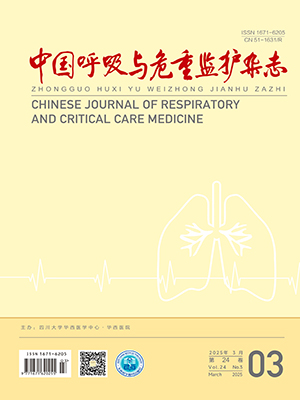| 1. |
Novosad SA, Winthrop KL. Beyond tumor necrosis factor inhibition: the expanding pipeline of biologic therapies for inflammatory diseases and their associated infectious sequelae. Clin Infect Dis, 2014, 58(11): 1587-1598.
|
| 2. |
Azoulay E, Lemiale V, Mokart D, et al. Acute respiratory distress syndrome in patients with malignancies. Intensive Care Med, 2014, 40(8): 1106-1114.
|
| 3. |
Azevedo LCP, Caruso P, Silva UVA, et al. Outcomes for patients with cancer admitted to the ICU requiring ventilatory support: results from a prospective multicenter study. Chest, 2014, 146(2): 257-266.
|
| 4. |
Molina R, Bernal T, Borges M, et al. Ventilatory support in critically ill hematology patients with respiratory failure. Crit Care, 2012, 16(4): R133.
|
| 5. |
中华医学会呼吸病学分会呼吸危重症医学学组, 中国医师协会呼吸医师分会危重症医学工作委员会. 成人经鼻高流量湿化氧疗临床规范应用专家共识. 中华结核和呼吸杂志, 2019, 42(2): 83-91.
|
| 6. |
潘红, 黄琴红, 许红阳, 等. 经鼻高流量湿化氧疗对肺移植受者肺康复效果的影响. 中华移植杂志(电子版), 2016, 10(4): 182-185.
|
| 7. |
Yoo JW, Synn A, Huh JW, et al. Clinical efficacy of high-flow nasal cannula compared to noninvasive ventilation in patients with post-extubation respiratory failure. Korean J Intern Med, 2016, 31(1): 82-88.
|
| 8. |
Frat JP, Thille AW, Mercat A, et al. High-flow oxygen through nasal cannula in acute hypoxemic respiratory failure. N Engl J Med, 2015, 372(23): 2185-2196.
|
| 9. |
Azoulay E, Lemiale V, Mokart D, et al. Effect of high-flow nasal oxygen vs standard oxygen on 28-day mortality in immunocompromised patients with acute respiratory failure: the high randomized clinical trial. JAMA, 2018, 320(20): 2099-2107.
|
| 10. |
Higgins JPT, Green S. Cochrane handbook for systematic reviews of interventions 5.1.0. London: The Cochrane Collsaboration, 2011, 8.
|
| 11. |
Stang A. Critical evaluation of the Newcastle-Ottawa scale for the assessment of the quality of nonrandomized studies in meta-analyses. Eur J Epidemiol, 2010, 25(9): 603-605.
|
| 12. |
Azoulay E, Pickkers P, Soares M, et al. Acute hypoxemic respiratory failure in immunocompromised patients: the Efraim multinational prospective cohort study. Intensive Care Med, 2017, 43(12): 1808-1819.
|
| 13. |
Coudroy R, Jamet A, Petua P, et al. High-flow nasal cannula oxygen therapy versus noninvasive ventilation in immunocompromised patients with acute respiratory failure: an observational cohort study. Ann Intensive Care, 2016, 6(1): 45.
|
| 14. |
Frat JP, Ragot S, Girault C, et al. Effect of non-invasive oxygenation strategies in immunocompromised patients with severe acute respiratory failure: a post-hoc analysis of a randomised trial. Lancet Respir Med, 2016, 4(8): 646-652.
|
| 15. |
Lemiale V, Mokart D, Mayaux J, et al. The effects of a 2-h trial of high-flow oxygen by nasal cannula versus venturi mask in immunocompromised patients with hypoxemic acute respiratory failure: a multicenter randomized trial. Crit Care, 2015, 19: 380.
|
| 16. |
Lemiale V, Resche-Rigon M, Mokart D, et al. High-flow nasal cannula oxygenation in immunocompromised patients with acute hypoxemic respiratory failure: A Groupe de Recherche Respiratoire en Réanimation Onco-Hématologique Study. Crit Care Med, 2017, 45(3): e274-e280.
|
| 17. |
Roca O, de Acilu MG, Caralt B, et al. Humidified high flow nasal cannula supportive therapy improves outcomes in lung transplant recipients readmitted to the intensive care unit because of acute respiratory failure. Transplantation, 2015, 99(5): 1092-1098.
|
| 18. |
Tu G, He H, Yin K, et al. High-flow nasal cannula versus noninvasive ventilation for treatment of acute hypoxemic respiratory failure in renal transplant recipients. Transplant Proc, 2017, 49(6): 1325-1330.
|
| 19. |
孙婷, 朱虎林. 经鼻导管高流量氧疗在肺癌根治术后呼吸衰竭患者中的临床应用. 中国实用护理杂志, 2017, 33(30): 2334-2338.
|
| 20. |
张乐, 唐理斌, 夏加伟, 等. 经鼻高流量湿化氧疗在艾滋病并急性低氧性呼吸衰竭中的应用研究. 中国急救医学, 2019, 39(9): 835-839.
|
| 21. |
李文龙, 张华, 徐超, 等. 经鼻高流量氧疗治疗特发性肺纤维化并呼吸衰竭. 实用医学杂志, 2017, 33(15): 2603-2604.
|
| 22. |
王大鹏, 聂晓伟, 潘红, 等. 经鼻高流量湿化氧疗治疗肺移植术后移植物失功患者的临床研究. 现代生物医学进展, 2017, 17(34): 6709-6712.
|
| 23. |
陈耿靖, 陈亮, 许红阳, 等. 经鼻高流量吸氧在肺移植术后患者呼吸衰竭的应用. 实用器官移植电子杂志, 2017, 5(5): 340-342.
|
| 24. |
陈耿靖, 许红阳, 潘虹, 等. 经鼻高流量氧疗在食管癌术后急性呼吸衰竭患者中的临床应用. 中国急救医学, 2018, 38(4): 301-304.
|
| 25. |
Blot F, Melot C. Indications, timing, and techniques of tracheostomy in 152 French ICUs. Chest, 2005, 127(4): 1347-1352.
|
| 26. |
Keenan SP, Sinuff T, Burns KE, et al. Clinical practice guidelines for the use of noninvasive positive-pressure ventilation and noninvasive continuous positive airway pressure in the acute care setting. CMAJ, 2011, 183(3): E195-E214.
|
| 27. |
吴丽娟. 关注呼吸衰竭治疗的新技术--加温加湿经鼻高流量氧疗. 中华医学杂志, 2017, 97(5): 321-324.
|
| 28. |
吕姗, 安友仲. 主动温湿化的经鼻高流量氧疗在成人患者中的应用. 中华危重病急救医学, 2016, 28(1): 84-88.
|
| 29. |
滕洪云, 杨万杰, 王玉梅, 等. 经鼻高流量湿化氧疗在爆震伤患者中的应用. 中国中西医结合急救杂志, 2016, 23(3): 287-290.
|
| 30. |
Frat JP, Brugiere B, Ragot S, et al. Sequential application of oxygen therapy via high-flow nasal cannula and noninvasive ventilation in acute respiratory failure: an observational pilot study. Respir Care, 2015, 60(2): 170-178.
|
| 31. |
Papazian L, Corley A, Hess D, et al. Use of high-flow nasal cannula oxygenation in ICU adults: a narrative review. Intensive Care Med, 2016, 42(9): 1336-1349.
|
| 32. |
Stéphan F, Barrucand B, Petit P, et al. High-flow nasal oxygen vs noninvasive positive airway pressure in hypoxemic patients after cardiothoracic surgery: a randomized clinical trial. JAMA, 2015, 313(23): 2331-2339.
|





 Baidu Scholar
Baidu Scholar